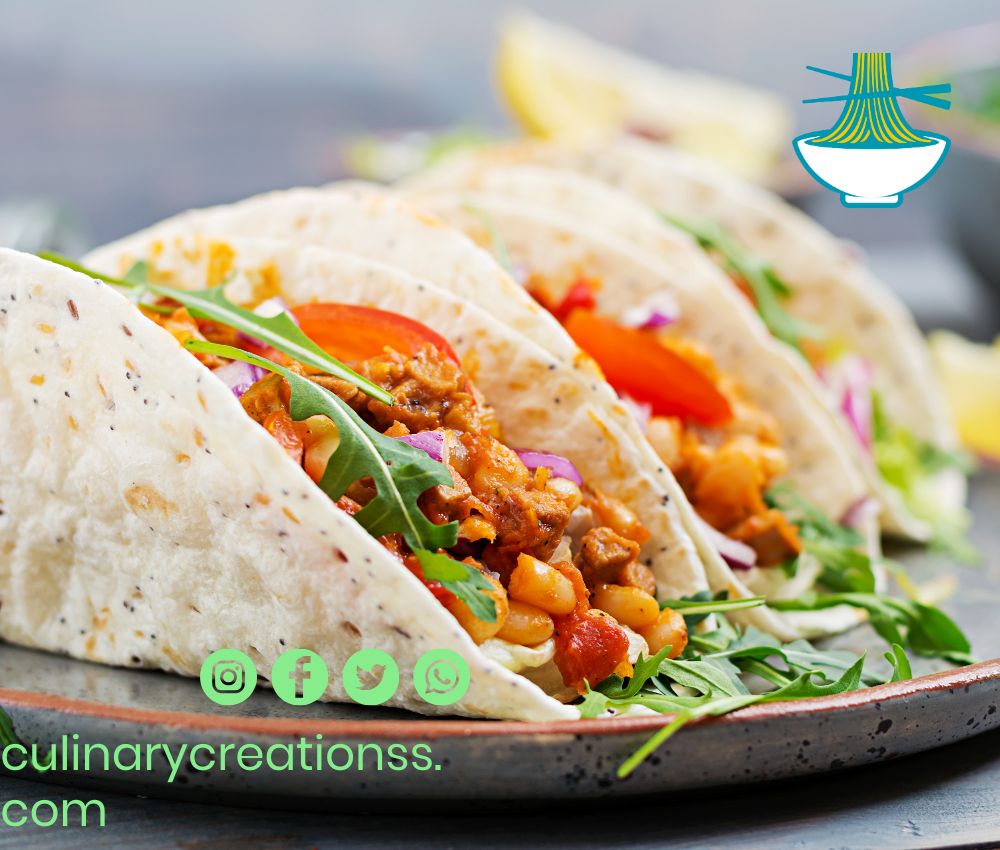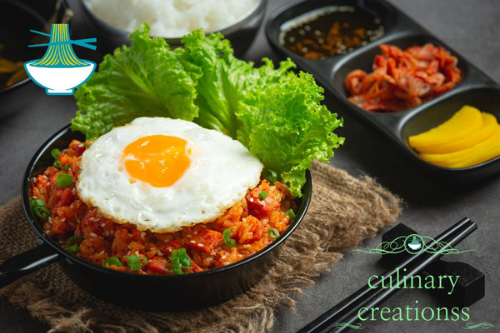Welcome to our kimchi culinary adventure! In this article, we're diving into a variety of unique kimchi recipes that not only tantalize your taste buds but also provide valuable insights into the nutritional value of each ingredient. Whether you're a kimchi enthusiast or a curious food explorer, our recipes offer a delightful blend of flavors, textures, and nutritional benefits. Get ready to elevate your kimchi experience with distinctive and delicious dishes.

Kimchi Tacos
Ingredients:
- Kimchi (1 cup, finely chopped)
- Thinly sliced beef or tofu (1 cup)
- Tortillas (4)
- Sriracha mayo (2 tbsp)
- Chopped cilantro (2 tbsp)
- Sliced green onions (2 tbsp)
Instructions:
- Sauté the beef or tofu until cooked through.
- Warm the tortillas.
- Layer kimchi, cooked protein, sriracha mayo, cilantro, and green onions on each tortilla.
- Fold and enjoy these zesty kimchi tacos with a fusion twist.

Nutrition Value
Kimchi (1 cup, finely chopped):
- Calories: Approximately 23 calories
- Carbohydrates: Approximately 4 grams
- Protein: Approximately 1 gram
- Fat: Approximately 0 grams
- Sodium: Varies depending on the brand and preparation, but it can range from 800mg to 1100mg per cup on average.
Thinly sliced beef (1 cup):
- Calories: Approximately 336 calories (varies based on the cut and cooking method)
- Carbohydrates: Approximately 0 grams
- Protein: Approximately 37 grams
- Fat: Approximately 21 grams (varies based on the cut)
- Sodium: Varies based on preparation and seasoning.
Tortillas (4):
- Calories: Approximately 320-400 calories (varies based on the type and size of tortillas)
- Carbohydrates: Approximately 64-80 grams
- Protein: Approximately 8-10 grams
- Fat: Approximately 4-8 grams
- Sodium: Varies based on the brand and type of tortillas.
Sriracha mayo (2 tbsp):
- Calories: Approximately 120-150 calories (varies based on the brand)
- Carbohydrates: Approximately 2-3 grams
- Protein: Approximately 0-1 gram
- Fat: Approximately 12-14 grams
- Sodium: Approximately 140-200mg (varies based on the brand).
Chopped cilantro (2 tbsp):
- Calories: Approximately 0 calories
- Carbohydrates: Approximately 0 grams
- Protein: Approximately 0 grams
- Fat: Approximately 0 grams
- Sodium: Approximately 0 mg
Sliced green onions (2 tbsp):
- Calories: Approximately 4-8 calories
- Carbohydrates: Approximately 1-2 grams
- Protein: Approximately 0-1 gram
- Fat: Approximately 0 grams
- Sodium: Approximately 0-2 mg

Kimchi Fried Rice
Ingredients:
- Cooked rice (2 cups)
- Kimchi (1 cup, chopped)
- Cooked chicken, shrimp, or tofu (1 cup)
- Soy sauce (2 tbsp)
- Sesame oil (1 tbsp)
- Sliced green onions (2 tbsp)
- Fried egg (optional)
Instructions:
- Heat sesame oil in a pan and add kimchi. Sauté for a few minutes.
- Add cooked protein and cooked rice, stirring continuously.
- Drizzle soy sauce and mix well.
- Garnish with green onions and top with a fried egg for an extra kick.
Nutrition Value
Cooked rice (2 cups):
- Calories: Approximately 400-450 calories (varies based on the type of rice)
- Carbohydrates: Approximately 88-100 grams
- Protein: Approximately 8-10 grams
- Fat: Approximately 0-2 grams
- Sodium: Varies depending on the preparation method, but it's generally low, around 0-10 mg.
Kimchi (1 cup, chopped):
- Calories: Approximately 23 calories
- Carbohydrates: Approximately 4 grams
- Protein: Approximately 1 gram
- Fat: Approximately 0 grams
- Sodium: Varies depending on the brand and preparation, but it can range from 800mg to 1100mg per cup on average.
Cooked chicken, shrimp, or tofu (1 cup):
- Calories: Varies based on the type and preparation method:
- Cooked chicken breast: Approximately 230 calories
- Cooked shrimp: Approximately 85-100 calories
- Cooked tofu: Approximately 176 calories (varies based on the type)
- Carbohydrates: Varies based on the type, but generally low (5-10 grams for chicken or shrimp, slightly higher for tofu)
- Protein: Approximately 25-30 grams for chicken, 18-20 grams for shrimp, and 8-12 grams for tofu
- Fat: Varies based on the type and preparation method, but generally low to moderate.
- Sodium: Varies based on preparation and seasoning.
Soy sauce (2 tbsp):
- Calories: Approximately 20-30 calories (varies based on the brand and type)
- Carbohydrates: Approximately 4-6 grams
- Protein: Approximately 2-3 grams
- Fat: Approximately 0 grams
- Sodium: Approximately 1400-2000mg (varies based on the brand and type).
Sesame oil (1 tbsp):
- Calories: Approximately 120-130 calories
- Carbohydrates: Approximately 0 grams
- Protein: Approximately 0 grams
- Fat: Approximately 14 grams
- Sodium: Approximately 0 mg
Sliced green onions (2 tbsp):
- Calories: Approximately 4-8 calories
- Carbohydrates: Approximately 1-2 grams
- Protein: Approximately 0-1 gram
- Fat: Approximately 0 grams
- Sodium: Approximately 0-2 mg
Fried egg (optional):
- Calories: Approximately 70-80 calories
- Carbohydrates: Approximately 0 grams
- Protein: Approximately 6 grams
- Fat: Approximately 5 grams
- Sodium: Approximately 60-70 mg

Kimchi Grilled Cheese
Ingredients:
- Sourdough bread slices (4)
- Kimchi (1 cup, drained)
- Sliced cheddar cheese (4 slices)
- Butter (2 tbsp)
Instructions:
- Butter one side of each bread slice.
- Layer kimchi and cheddar cheese between two slices.
- Grill the sandwich until golden brown and the cheese is melted.
- Serve your unique kimchi grilled cheese with a side of kimchi slaw for a spicy twist.
Nutrition Value
Sourdough bread slices (4):
- Calories: Approximately 300-400 calories (varies based on the size and brand of bread)
- Carbohydrates: Approximately 60-80 grams
- Protein: Approximately 10-16 grams
- Fat: Approximately 2-4 grams
- Sodium: Varies based on the brand and type, but it's generally around 400-600mg for four slices.
Kimchi (1 cup, drained):
- Calories: Approximately 23 calories
- Carbohydrates: Approximately 4 grams
- Protein: Approximately 1 gram
- Fat: Approximately 0 grams
- Sodium: Varies depending on the brand and preparation, but it can range from 800mg to 1100mg per cup on average.
Sliced cheddar cheese (4 slices):
- Calories: Approximately 320-400 calories (varies based on the brand and thickness of slices)
- Carbohydrates: Approximately 0-4 grams
- Protein: Approximately 16-20 grams
- Fat: Approximately 24-32 grams
- Sodium: Approximately 400-600mg (varies based on the brand).
Butter (2 tbsp):
- Calories: Approximately 200 calories
- Carbohydrates: Approximately 0 grams
- Protein: Approximately 0 grams
- Fat: Approximately 22 grams
- Sodium: Approximately 140-160mg

Vegan Kimchi Ramen
Ingredients:
- Ramen noodles (2 packs)
- Kimchi (1 cup, chopped)
- Vegetable broth (4 cups)
- Sliced shiitake mushrooms (1 cup)
- Bok choy (2 heads, chopped)
- Sriracha sauce (2 tbsp)
- Sesame seeds (for garnish)
Instructions:
- Cook ramen noodles according to package instructions.
- In a separate pot, heat vegetable broth and add mushrooms and bok choy.
- Once the vegetables are tender, add kimchi and sriracha sauce.
- Serve the kimchi ramen with cooked noodles and garnish with sesame seeds.
Nutrition Value
Ramen noodles (2 packs):
- Calories: Approximately 400-450 calories per pack (varies based on the brand and type)
- Carbohydrates: Approximately 80-90 grams per pack
- Protein: Approximately 8-10 grams per pack
- Fat: Approximately 12-15 grams per pack
- Sodium: Varies based on the brand and type but can be high, ranging from 1500-2000mg per pack or more.
Kimchi (1 cup, chopped):
- Calories: Approximately 23 calories
- Carbohydrates: Approximately 4 grams
- Protein: Approximately 1 gram
- Fat: Approximately 0 grams
- Sodium: Varies depending on the brand and preparation, but it can range from 800mg to 1100mg per cup on average.
Vegetable broth (4 cups):
- Calories: Approximately 10-20 calories per cup (varies based on the brand and type)
- Carbohydrates: Approximately 2-4 grams per cup
- Protein: Approximately 0-1 gram per cup
- Fat: Approximately 0 grams per cup
- Sodium: Varies based on the brand and type but can range from 400-800mg per cup or more.
Sliced shiitake mushrooms (1 cup):
- Calories: Approximately 15-25 calories
- Carbohydrates: Approximately 3-5 grams
- Protein: Approximately 2-3 grams
- Fat: Approximately 0-1 gram
- Sodium: Approximately 0-2 mg
Bok choy (2 heads, chopped):
- Calories: Approximately 40-60 calories
- Carbohydrates: Approximately 8-12 grams
- Protein: Approximately 4-6 grams
- Fat: Approximately 0-1 gram
- Sodium: Approximately 150-300mg
Sriracha sauce (2 tbsp):
- Calories: Approximately 20-30 calories
- Carbohydrates: Approximately 4-6 grams
- Protein: Approximately 0-1 gram
- Fat: Approximately 0 grams
- Sodium: Approximately 140-200mg
Sesame seeds (for garnish):
- Calories: Approximately 50-60 calories per tablespoon
- Carbohydrates: Approximately 2-3 grams per tablespoon
- Protein: Approximately 2-3 grams per tablespoon
- Fat: Approximately 4-5 grams per tablespoon
- Sodium: Approximately 0-2 mg per tablespoon
Kimchi's versatility knows no bounds, and these unique recipes are sure to delight your palate. From kimchi tacos to vegan ramen, these creative twists on the Korean classic will satisfy both your craving for something new and your search for distinctive kimchi recipes. Enjoy experimenting with these flavorful dishes!


Comments